By SARAH McCLEAVE
Émilie Bigottini (1784-1858) is an example of a dancer who successfully negotiated a complicated personal life and a glittering professional career. Born into a theatrical family, she studied at the ballet school of the Paris Opéra, joining its corps de ballet in 1801. Three years later she was promoted to soloist, becoming a principal dancer in 1813. Her moving performance in the title-role of Louis Milon’s Nina, ou La Folle par l’Amour (1813) is considered her “greatest triumph”.1 My interest in this dancer was piqued by reading some of her correspondence in the New York Public Library, which documents part of Bigottini’s dispute with the estate of Monsieur Casimir Louis Gousagne Marie Alphonse Ormand Pignatelly. Pignatelly was the father of her daughter Amadine Alphonsine (b. 10 April 1807). In a letter to a social contact (M. de Joli, mayor of Creteil) dated 23 July 1812 we learn that Bigottini is constrained from contesting the succession of Pignatelly’s estate, designated to fall to his nephew. She notes that three-eighths of the estate has been set aside her their daughter – but verbally Pignatelly had indicated she would receive more than this. Referring to the ‘prejudice’ of Pignatelly’s executor, the dancer declares her intention to secure “an honourable existence” (une existence honorable) for herself and their daughter.2 Whether she secured a larger portion of Pignatelly’s estate or not, we can assume that Bigottini achieved her ultimate aim as her daughter – described as “a wealthy woman” – was subsequently to marry the respectable notary Jean Baptise Daloz in 1827.3 Sadly, Amandine would predecease her mother by some 25 years. Bigottini’s fortune at her death is reported as amounting to 3.5 million francs, which she used to set up a charitable foundation.4
Despite her financial status, Bigottini’s cares as a mother would continue: in a letter dated 14 June 1822 she wrote the Opéra management to serve notice that she could not perform due to the continued indisposition of her daughter.5 Bigottini’s correspondence reveals a side to the lives of many female dancers, particularly those with children born outside the institution of marriage. Futures had to be secured (a notably delicate matter in the case of a daughter), and care arranged. Bigottini had two additional children with General Géraud-Christophe-Michel Duroc and counted amongst her lovers Napoleon’s stepson Eugène de Beauharnais. Her biographer Bouvier prefers to emphasise the financial benefits Bigottini accrued through these relationships, but her correspondence reveals the worry and the work behind the apparent façade of easy comfort. Notably, Bigottini preferred to remain an active professional until the age of 39 rather than to retire early on the fortunes of her lovers.
Bigottini was the subject of several portraits. The image that best captures a vivacious personality in performance is Jacques Vallin’s depiction of her in the role of a bacchante – this can be discovered by scrolling through the online gallery of the Bowes Museum. Further personal portraits of this dancer exist — including a most elegant pencilled image of the dancer in motion drawn by Louis Lafitte (1770-1828). In this blog we will consider instead a selection of images that represent the institutional interests of the Académie Royale de Musique.
Online digital collections such as Gallica (https://gallica.bnf.fr/) and the New York Public Library (https://digitalcollections.nypl.org/) evidence the existence of various commercial series of images, promoted by the theatres of Paris and featuring their performance personnel. These series are particularly notable from the 1820s. The four costume prints show below have Godefroy Engelmann (1788-1839) as the lithographer. According to The Dictionary of Art, he was ‘instrumental’ in promoting and developing lithography in Paris from the mid 1810s until his death in 1839, so the Paris Opéra was paying for an accomplished artist.6 First we have Bigottini in the title-role of Clari, a ballet-pantomime by Louis Milon with music by Rodolphe Kreutzer first performed on 19 June 1820. Clari is the daughter of a rich farmer but has been kidnapped by the Duc Melville and brought up as his daughter. The ballet’s sub-title suggests its focus: ‘La promesse de la mariage’. Here we can compare Bigottini with one Mme Courtin. The most personalised aspect of these images is the evident difference to the dancers’ figures; Mme Courtin has a protruding bust while Bigottini does not. Clearly the interest lies in the costumes rather than the personalities of the dancers.
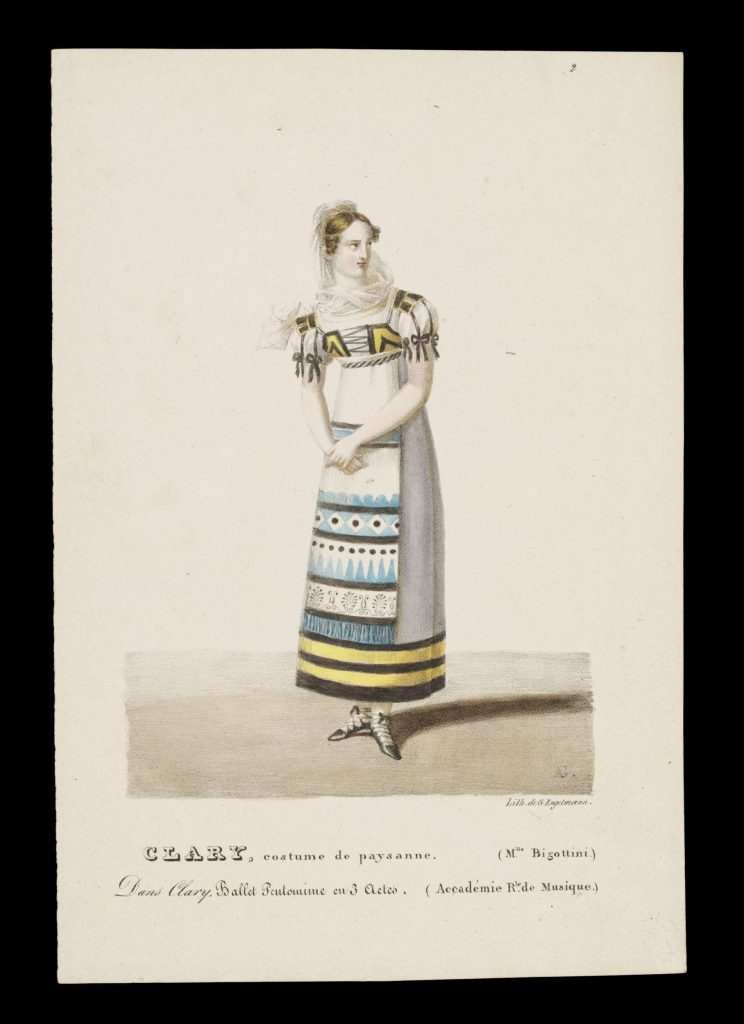
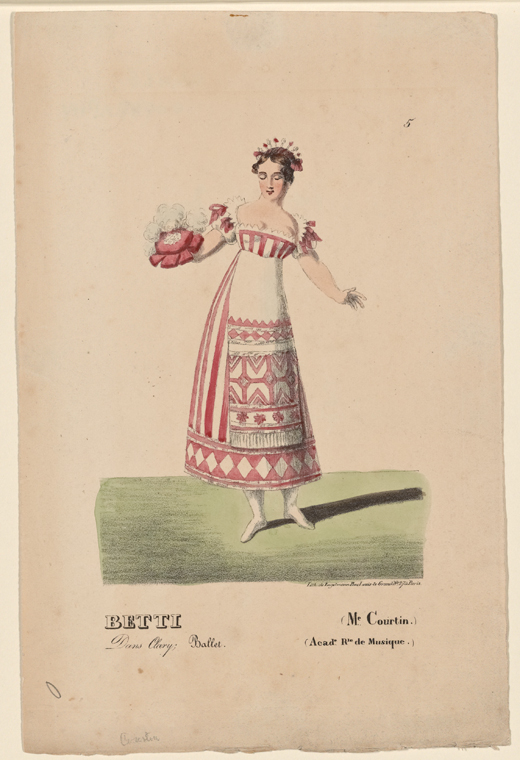
Image left: Bigottini in Clary (1820), lithograph G. Engelmann, copyright Victoria and Albert Museum. Image right: Mme. Courtin in Clary, lithograph G. Engelmann, copy New York Public Library.
We also see Bigottini as Victor in Jean-Pierre Aumer’s ballet, Les pages du duc de Vendôme. This pantomime-ballet, with music by Adalbert Gyrowetz, opened at the Paris Opéra on 18 October 1820. Victor is the son of Marimon, an elderly Colonel. Engelmann’s rendition of Aumer in the title-role makes an interesting juxtaposition with Bigottini in her trousers role. The costumes are broadly similar, although Aumer’s has stronger lines while there is a softness to both Bigottini’s costume and her pose. Aumer’s boots are far more substantial, and he alone bears a sword.
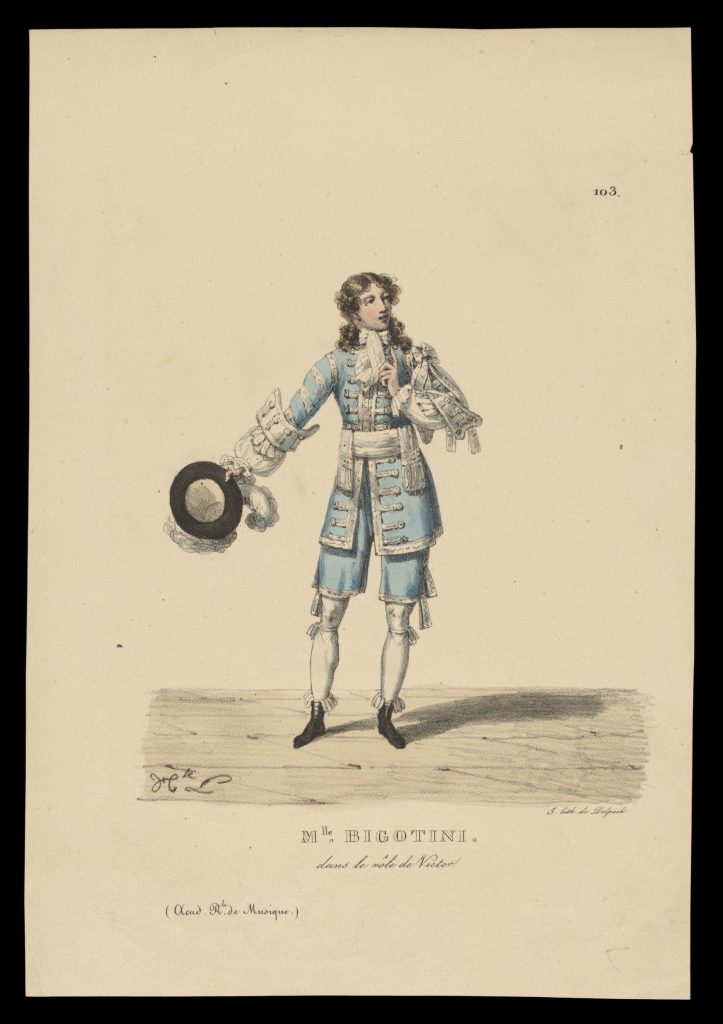
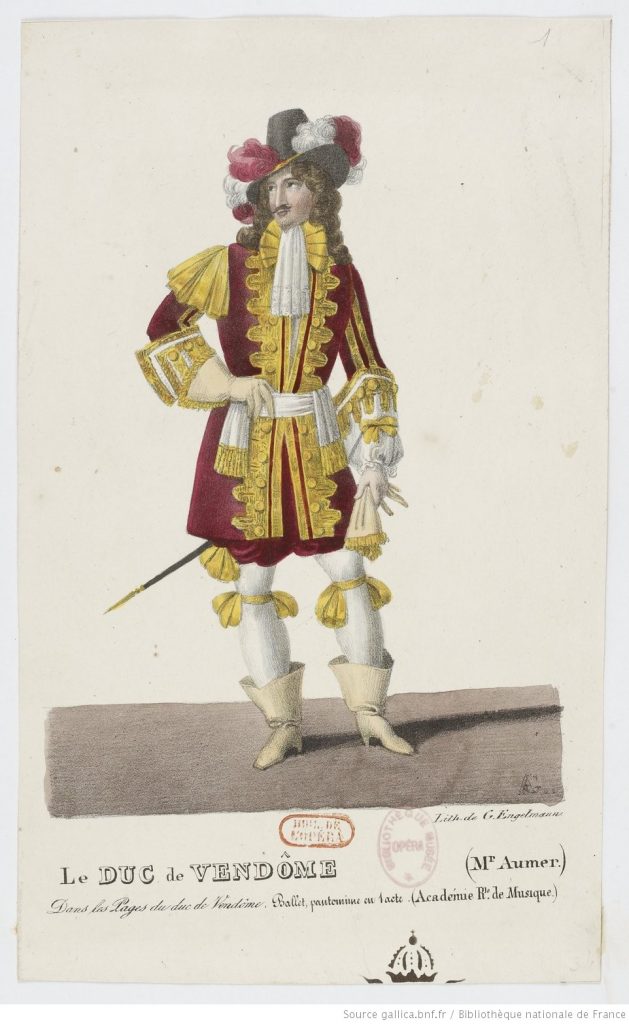
My final selection for this blog shows Bigottini and her younger peer Lise Noblet (1801-1852) as drawn by Pierre Roch Vigneron (1789-1872) for a series ‘Collection du Corsaire’. Gallica describes ‘Le Corsaire’ as a publisher, but the print of Noblet was published by its lithographic printer, C. de Lasteyrie. These portraits appear very generic, conveying a limited sense of the personality or essence of the sitters; the backgrounds suggest a highly smudged outdoor locale that would have taken a minimum of trouble to produce. Presumably they were mass produced for the cheaper end of the art market. Gallica holds further portraits from this series, including artists from the Théâtre-Français and the Théâtre des Nouveautés, engraved by Engelmann, or by one Demanne.7 The artist and lithographer Vigneron was also apparently active as a portraitist for the ‘Collection du Courrier des Spectacles’, which produced thespian images in a similar style and format.
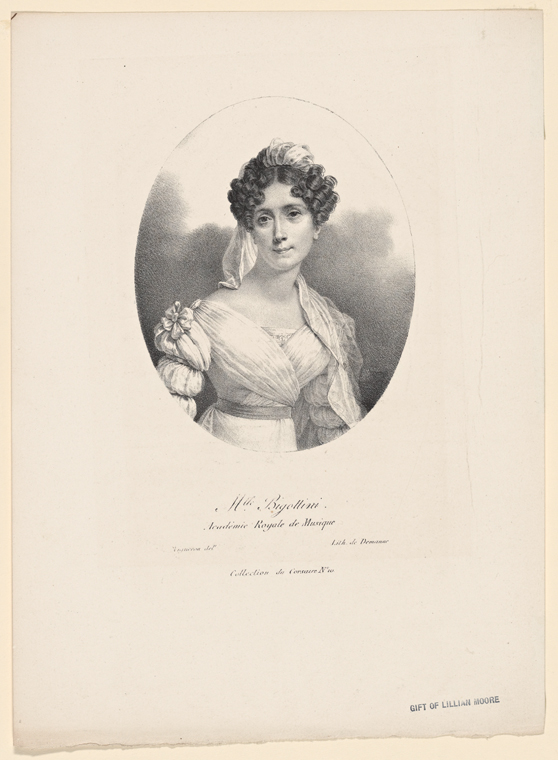

The commercial reproduction of costume sketches as well as portraits by the third decade of the nineteenth century offers a proliferation of images related to performers in the Parisian theatres – particularly the Opéra. This kind of infrastructure was not in operation in London during the same period. Indeed, from our first post regarding Mlle Subligny we have drawn on this earlier development of performer portraiture in Paris. It is interesting to speculate what the visual legacy regarding Mlle Parisot might have been, had she remained in Paris rather than chancing her luck in London. Bigottini – who never danced in London – was at least spared the London satirists.
References
- Babsky, M. 2005. ‘Bigottini, Émilie.’ International Encyclopedia of Dance. www-oxfordreference-com.
- ‘Émilie Bigottini.’ Walter Toscanini Collection volume 3. New York Public Library.
- Petit-Konczyk, M. 2015. The Creators of the north France coastal forest from 1845 to 1885, p. 9. ResearchGate; see also Bouvier, F. 1909. Une danseuse de l’Opéra : La Bigottini. Paris: N. Charavay, p. 29.
- Bouvier, p. 32n2.
- ‘Émilie Bigottini.’ Walter Toscanini Collection volume 3. New York Public Library.
- ‘Engelmann, Godefroy.’ 1996. The Dictionary of Art. Edited by Jane Turner. London: Macmillan.
- Emilia Bigottini (1825), Mlle Quiney of the Académie Royale de Musique (lithographer Engelmann), Nicola-Baptiste Anselm of the Théâtre-Français (lithographer Demanne), and Mme Albert (Louise Albert-Himm) of the Théâtre des Nouveautés.
Next post
The next post will consider portraits of the dancer Marie Sallé (1709-1756).